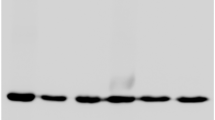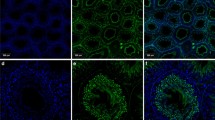Abstract
The transepithelial movement of water into the male reproductive tract is an essential process for normal male fertility. Protein water channels, referred to as aquaporins (AQPs), are involved in increasing the osmotic permeability of membranes. This study has examined the expression of AQP1, AQP2, and AQP7 in epithelial cells in adult dog efferent ducts, epididymis, and vas deferens. Samples of dog male reproductive tract comprising fragments of the testis, initial segment, caput, corpus and cauda epididymidis, and vas deferens were investigated by immunohistochemistry and Western blotting procedures to show the localization and distribution of the AQPs. AQP1 was noted in rete testis, in efferent ducts, and in vessels in the intertubular space, suggesting that AQP1 participated in the absorption of the large amount of testicular fluid occurring characteristically in the efferent ducts. AQP2 expression was found in the rete testis, efferent ducts and epididymis, whereas AQP7 was expressed in the epithelium of the proximal regions of the epididymis and in the vas deferens. This is the first time that AQP2 and AQP7 have been observed in these regions of mammalian excurrent ducts, but their functional role in the dog male reproductive tract remains unknown. Investigations of AQP biology could be relevant for clinical studies of the male reproductive tract and to technologies for assisted procreation.




Similar content being viewed by others
References
Agre P, Brown D, Nielsen S (1995) Aquaporin water channels: unanswered questions and unresolved controversies. Curr Opin Cell Biol 7:472–483
Badran HH, Hermo LS (2002) Expression and regulation of aquaporins 1, 8 and 9 in the testis, efferent ducts, and epididymis of adult rats and during postnatal development. J Androl 23:358–373
Bradford MM (1976) A rapid and sensitive method for the quantitation of microgram quantities of protein utilizing the principle of protein-dye binding. Anal Biochem 72:248–254
Brown D, Verbavatz JM, Valenti G, Lui B, Sabolic I (1993) Localization of the CHIP28 water channel in reabsorptive segments of the rat male reproductive tract. Eur J Cell Biol 61:264–273
Calamita G, Mazzone A, Bizzoca A, Svelto M (2001a) Possible involvement of aquaporin-7 and -8 in rat testis development and spermatogenesis. Biochem Biophys Res Commun 288:619–625
Calamita G, Mazzone A, Cho YS, Valenti G, Svelto M (2001b) Expression and localization of the aquaporin-8 water channel in rat testis. Biol Reprod 64:1660–1666
Cho YS, Svelto M, Calamita G (2003) Possible functional implications of aquaporin water channels in reproductive physiology and medically assisted procreation. Cell Mol Biol 49:515–519
Clulow J, Jones RC, Hansen LA, Man SY (1998) Fluid and electrolyte reabsorption in the ductuli efferentes testis. J Reprod Fertl 53 (Suppl):1–14
Da Silva N, Piétrement C, Brown D, Breton S (2006a) Segmental and cellular expression of aquaporins in the male excurrent duct. Biochim Biophys Acta 1758:1025–1033
Da Silva N, Silberstein C, Beaulieu V, Piétrement C, Hoek ANV, Brown D, Breton S (2006b) Postnatal expression of aquaporins in epithelial cells of the rat epididymis. Biol Reprod 74:427–438
Denker BM, Smith BL, Kuhajda FP, Agre P (1988) Identification, purification, and partial characterization of a novel M 28,000 integral membrane protein from erythrocytes and renal tubules. J Biol Chem 263:634–642
Domeniconi RF, Orsi AM, Justulin LA Jr, Beu CC, Felisbino SL (2007) Aquaporin 9 (AQP9) localization in the adult dog testis excurrent ducts by immunohistochemistry. Anat Rec 290:1519–1525
Fisher JS, Turner KJ, Fraser HM, Saunders PTK, Brown D, Sharpe M (1998) Immunoexpression of aquaporin-1 in the efferent ducts of the rat and marmoset monkey during development, its modulation by estrogens, and its possible role in fluid resorption. Endocrinology 139:3935–3945
Flickinger CJ, Howards SS, English HF (1978) Ultrastructural differences in efferent ducts and several regions of the epididymis of the hamster. Am J Anat 152:557–585
Hess RA, Zhou Q, Nie R (2002) The role of estrogens in the endocrine and paracrine regulation of the efferent ductules, epididymis and vas deferens. In: Robaire B, Hinton B (eds) The epididymis: from molecules to clinical practice. Kluwer Academic/Plenum, New York, pp 317–337
Hinton BT, Setchell BP (1993) Fluid secretion and movement. In: Russell L, Griswold M (eds) The Sertolli cell. Cache River, Clearwater, pp 249–267
Ishibashi K, Kuwahara M, Gu Y, Kageyama Y, Tohsaka A, Suzuki F, Marumo F, Sasaki S (1997) Cloning and functional expression of a new water channel abundantly expressed in the testis permeable to water, glycerol, and urea. J Biol Cell 272:20782–20786
Kirchhoff C (2002) The dog as a model to study human epididymal function at a molecular level. Mol Hum Reprod 8:695–701
Matsuzaki T, Tajiki Y, Tserentsoodol N, Suzuki T, Aoki T, Hagiwara H, Takata K (2002) Aquaporins: a water channel family. Anat Sci Int 77:85–93
Nelson RD, Stricklett P, Gustafson C, Stevens A, Ausiello D, Brown D, Kohan DE (1998) Expression of an AQP2 Cre recombinase transgene in kidney and male reproductive system of transgenic mice. Am J Physiol Cell Physiol 275:C216–C226
Nielsen S, Chou CL, Marples D, Christensen EI, Kishore BK, Knepper MA (1995) Vasopressin increases water permeability of kidney collecting duct by inducing translocation of aquaporin-CD water channels to plasma membrane. Proc Natl Acad Sci USA 92:1013–1017
Oliveira CA, Carnes K, França LR, Hermo L, Hess RA (2005) Aquaporin-1 and –9 are differentially regulated by oestrogen in the efferent ductule epithelium and initial segment of the epididymis. Biol Cell 97:385–395
Preston GM, Agre P (1991) Isolation of the cDNA for erythrocyte integral membrane protein of 28 kDa: member of an ancient channel family. Proc Natl Acad Sci USA 88:11110–11114
Schimming BC, Vicentini CA, Orsi AM, Franceschini-Vicentini IB, Abreu-Rays MA (1997) Regional histology of the ductus epididymidis in the dog (Canis familiaris, L.). Rev Chil Anat 15:5–12
Setchell BP, Maddocks S, Brooks DE (1994) Anatomy, vasculature, innervation, and fluids of the male reproductive tract. In: Knobil E, Neill JD (eds) The physiology of reproduction. Raven, New York, pp 1063–1147
Stevens AL, Breton S, Gustafson CE, Bouley R, Nelson RD, Kohan DE, Brown D (2000) Aquaporin-2 is a vasopressin-independent, constitutive apical membrane protein in rat vas deferens. Am J Physiol Cell Physiol 278:C791–C802
Suzuki-Toyota F, Ishibashi K, Yuasa S (1999) Immunohistochemical localization of a water channel, aquaporin 7 (AQP7), in the rat testis. Cell Tissue Res 295:279–285
Verkman AS, Mitra AK (2000) Structure and function of aquaporin water channels. Am J Physiol Renal Physiol 278:F13–F28
Vicentini CA, Orsi AM, Gregório EA (1990) Fine structure of ductuli efferentes of the hamster (Mesocricetus auratus). Gegenbaurs Morphol Jahrb Leipzig 136:111–118
Zaniboni L, Akuffo V, Bakst MR (2004) Aquaporins are observed in the duct epithelia of the epididymal region of the large white turkey. Poultry Sci 83:1917–1920
Acknowledgements
Special thanks are due to Dr. Stélio Pacca Loureiro Luna, Associate Professor of Veterinary School of UNESP at Botucatu. We are also indebted to Dr. Patrícia F. F. Pinheiro and to Dr. Sérgio Pereira from our department for collaboration and helpful discussions.
Author information
Authors and Affiliations
Corresponding author
Additional information
R.F.D. gratefully acknowledges a Fellowship from the Department of Anatomy, Institute of Biosciences, UNESP, Botucatu, SP, Brazil. This work was also funded by FAPESP (Sao Paulo State Research Foundation; grant 04/05578–1 to A.M.O. and grant 04/05579–8 to R.F.D.).
This paper is part of the PhD Thesis presented by R.F.D. to the State University of Campinas – UNICAMP, Brazil.
Rights and permissions
About this article
Cite this article
Domeniconi, R.F., Orsi, A.M., Justulin, L.A. et al. Immunolocalization of aquaporins 1, 2 and 7 in rete testis, efferent ducts, epididymis and vas deferens of adult dog. Cell Tissue Res 332, 329–335 (2008). https://doi.org/10.1007/s00441-008-0592-x
Received:
Accepted:
Published:
Issue Date:
DOI: https://doi.org/10.1007/s00441-008-0592-x




